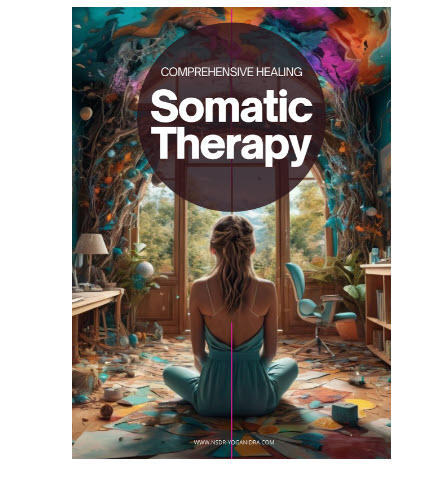Unlocking the Body’s Wisdom with a deep Dive deep into how Somatic Experiencing Therapy can revolutionize your healing process. At Sleep Dragon we think this can be a complimentary practice or alternative to Yoga Nidra. In this blog post we share personal anecdotes, and share its benefits and why it might be the breakthrough you’ve been seeking.
What is Somatic Therapy and how is it used?
In the realm of trauma therapy, traditional talk therapy has long been the go-to method for treatment. However, as our understanding of trauma evolves, alternative approaches are gaining traction. One such approach is Somatic Experiencing (SE), developed by renowned therapist Dr. Peter Levine. SE offers a fresh perspective on trauma resolution, tapping into the body’s innate wisdom to facilitate healing. Interestingly enough, a lot of the breathwork feels similar to breathing in certain Kriyas and Peter Levine himself in one of his podcasts calls it similar to the ‘awakening of the kundalini energy in the Mooladhara chakra or first chakra where fear and trauma is often stuck and immobilized’. In this comprehensive guide, we’ll explore the core concepts of Somatic Experiencing therapy, including somatic breathwork, somatic exercises, finding a somatic therapist that works for you, and addressing somatic pain. Through this exploration, you’ll gain insight into how SE can transform your healing journey.
Understanding Somatic Experiencing
Somatic Experiencing is a therapeutic approach that recognizes trauma as not just a psychological phenomenon but also a physiological one. My first SE session was such a release of heaviness and emotion from the body and after an hour of breathing I simply felt weightless. Dr. Levine mentions that traumatic experiences can lead to dysregulation of the nervous system, resulting in a myriad of physical and emotional symptoms and through SE this dysregulation by focusing on bodily sensations and responses brings the body into a state of equilibrium. His methodology does not solely rely on verbal communication. Research published in the “Journal of Traumatic Stress” highlights the efficacy of SE in reducing symptoms of post-traumatic stress disorder (PTSD) and improving overall well-being in trauma survivors (Ogden et al., 2006).
Exploring Somatic Breathwork
Somatic breathwork is a cornerstone of Somatic Experiencing therapy, designed to regulate the nervous system and access deeper layers of somatic experience. Through conscious breathing techniques, individuals can release tension and cultivate a sense of calmness and relaxation. This methodology is different from pranayamas and yoga nidra or yogic sleep practices but has a certain amount of overlap. There is repetitive breathing and certain patterns of breathwork- quick and slow to help release stuck energy in the body.The modality you choose depends on the extent of your trauma and the guidance of your health care provider.
A study published in the ‘Journal of Bodywork and Movement Therapies’ by Payne (2015) demonstrated the effectiveness of somatic breathwork in reducing chronic pain and improving physical function. By incorporating somatic breathwork into their practice, therapists help clients harness the power of their breath to promote healing.
Embracing Somatic Exercises
Somatic exercises play a vital role in restoring the body’s natural capacity for self-regulation. These exercises often involve gentle movements and mindfulness practices aimed at increasing body awareness and promoting emotional resilience.
Research has shown that engaging in somatic exercises can lead to significant reductions in pain intensity and increased mobility. By incorporating somatic exercises into their daily routine, individuals can reconnect with their bodies and foster a sense of safety and control. Many of our students practicing Somatic breathwork have felt a huge shift in their mental state of being.
Somatic Therapies:
1. Somatic Experiencing (SE): Developed by Dr. Peter Levine, SE focuses on renegotiating and discharging residual energy from traumatic experiences stored in the body, leading to empowerment and resilience. You can find the breath work here.
2. Hakomi Therapy: This mindfulness-centered somatic therapy integrates Eastern philosophy with Western psychotherapy, aiming to access and transform core beliefs and emotional patterns through somatic awareness.
Breathwork for Somatic Therapy
1. Holotropic Breathwork: Utilizes deep, rhythmic breathing to induce altered states of consciousness, facilitating emotional release, self-discovery, and healing on multiple levels.
2. Pranayama: Derived from yoga, pranayama consists of various breathing techniques aimed at regulating the flow of prana (life force energy) in the body, promoting relaxation, clarity of mind, and vitality. Think of this as a body scan in Yoga Nidra. Most therapy will have some kind of breathing exercise.
These are just some of the few ways to help release trauma and support the nervous system. Many of these modalities or a combination of a few will be used by the therapist to work with their clients and students.
Finding a Somatic Therapist Near You
Finding a qualified Somatic Therapist is essential for those seeking to embark on a journey of healing through Somatic Experiencing therapy. Somatic Therapists undergo extensive training in SE techniques and are skilled in creating a safe and supportive environment for trauma healing. Online directories and referrals from mental health professionals are valuable resources for finding a Somatic Therapist in your area. By working with a knowledgeable and compassionate therapist, individuals can receive personalized guidance and support on their healing journey. Find the online directory here.
Addressing Somatic Pain
Somatic pain, often associated with unresolved trauma, can manifest as physical discomfort or tension in various parts of the body. Somatic Experiencing offers a unique approach to addressing somatic pain by recognizing its underlying emotional and psychological roots. Through SE techniques, individuals can learn to release the trapped energy associated with somatic pain and restore balance to their nervous systems. Research published in the ‘Journal of Psychosomatic Research’ has demonstrated the effectiveness of Somatic Experiencing in reducing somatic pain symptoms (Price et al., 2012).
By addressing somatic pain through SE therapy, individuals can experience profound relief and healing and indeed one finds that the pain may not reduce over a few sessions but consistent practice over a period of time will help support healing not simply through talking (which of course is very essential for many individuals) but in addition to that actually helps individuals release the trauma from their cells which would otherwise turn into other symptoms or diseases later in life. While on the topic of Somatic therapy you can also check blog posts on dealing with trauma, chronic pain and depression with Yoga Nidra.
Finding yourself through Somatic Therapy
Somatic Experiencing therapy offers a holistic approach to trauma healing, harnessing the body’s innate wisdom to facilitate recovery. Through techniques such as somatic breathwork and somatic exercises, individuals can regulate their nervous systems and release trauma stored in the body. By working with a skilled Somatic Therapist, individuals can embark on a transformative journey of healing and reclaim their lives from the grip of past experiences. As research continues to validate the efficacy of Somatic Experiencing, it holds promise as a powerful tool for healing trauma and restoring wholeness to those who seek it.



